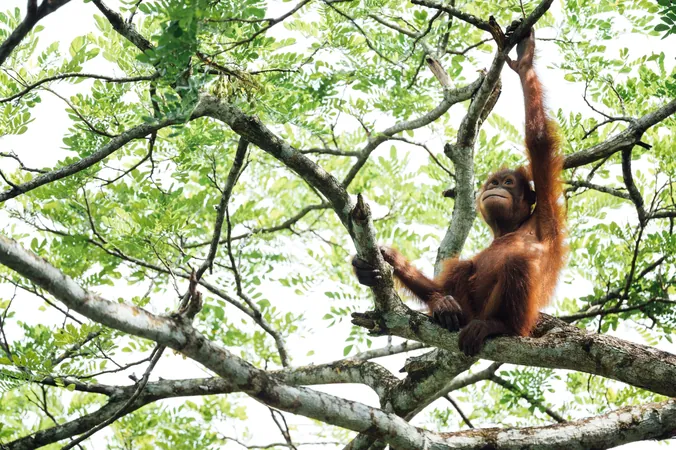
Breakthrough Discovery: Orangutans Exhibit Complex Communication Skills Previously Believed to be Unique to Humans!
2025-05-16
Author: Wei
In a groundbreaking study from the University of Warwick, researchers have unveiled a stunning revelation: wild orangutans possess vocal communication skills exhibiting a layered complexity once thought to be distinctly human. This discovery hints at a much deeper evolutionary heritage than previously believed.
Unpacking the Power of Recursion in Language
Imagine the phrase: "This is the dog that chased the cat that killed the rat that ate the cheese." It’s a simple sentence showcasing what linguists call recursion—where elements of a sentence are nested within each other. This allows us to create a nearly infinite variety of messages from a limited set of components, resembling Russian nesting dolls.
The Study That Shattered Preconceived Notions
Common wisdom held that this intricate form of communication, known as recursion, was a unique hallmark of human language, facilitating complex thought. However, the findings published in the *Annals of the New York Academy of Sciences* turn this notion on its head.
Dr. Chiara De Gregorio, a research fellow at the University of Warwick, along with colleagues Adriano Lameira and Marco Gamba, meticulously analyzed alarm calls from female Sumatran orangutans. They discovered a remarkable rhythmic structure in these vocalizations, demonstrating self-embedded communication across three distinct levels—a compelling instance of third-order recursion.
A Symphony of Sounds: The Structure of Orangutan Calls
The layered communication of orangutans unfolds as follows: 1. Individual sounds form small combinations (the first layer). 2. These combinations build into larger groups (the second layer). 3. The final layer groups these larger sets into even broader series, all maintaining a beat that echoes throughout each level.
Much like a piece of music, orangutans interweave rhythms in a sophisticated manner previously unobserved in non-human great apes.
Dynamic Communication: Responding to Danger
This intricate patterning isn't just random noise; it shows adaptability. When faced with real threats like tigers, orangutan calls become quicker and more urgent. In contrast, if the perceived danger falls short—like a mere piece of colorful cloth—their calls slow down, losing some of their rhythmic regularity. This capacity to modify vocalizations reveals a deeper level of communication, where each sound translates meaningful information regarding their environment.
Implications of This Discovery
Dr. De Gregorio emphasizes the significance of this discovery: "This finding illustrates that recursion, one of the most defining traits of human language, has roots that date back to our evolutionary ancestors. Orangutans are offering us crucial insights into how the foundations of language might have started to develop millions of years ago."
This pioneering research is the first empirical evidence supporting the idea that powerful recursive abilities could have evolved gradually in our ancient relatives, challenging everything we thought we knew about language and communication in the animal kingdom.


 Brasil (PT)
Brasil (PT)
 Canada (EN)
Canada (EN)
 Chile (ES)
Chile (ES)
 Česko (CS)
Česko (CS)
 대한민국 (KO)
대한민국 (KO)
 España (ES)
España (ES)
 France (FR)
France (FR)
 Hong Kong (EN)
Hong Kong (EN)
 Italia (IT)
Italia (IT)
 日本 (JA)
日本 (JA)
 Magyarország (HU)
Magyarország (HU)
 Norge (NO)
Norge (NO)
 Polska (PL)
Polska (PL)
 Schweiz (DE)
Schweiz (DE)
 Singapore (EN)
Singapore (EN)
 Sverige (SV)
Sverige (SV)
 Suomi (FI)
Suomi (FI)
 Türkiye (TR)
Türkiye (TR)
 الإمارات العربية المتحدة (AR)
الإمارات العربية المتحدة (AR)